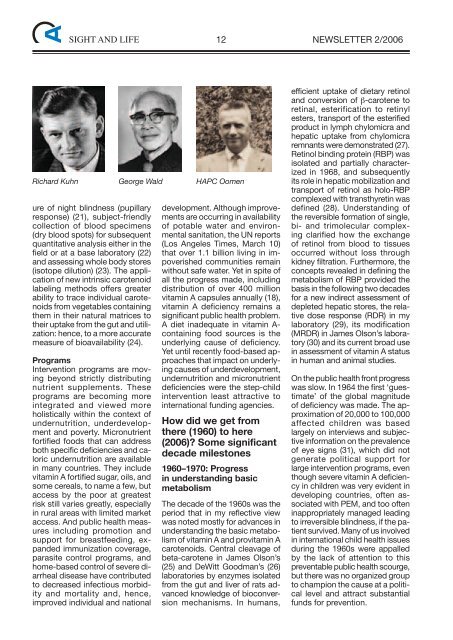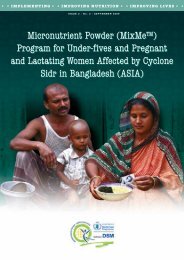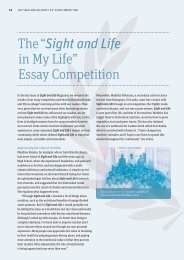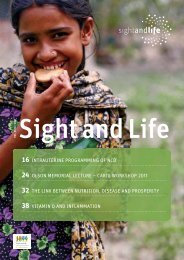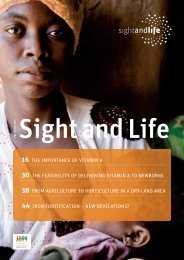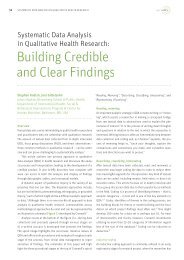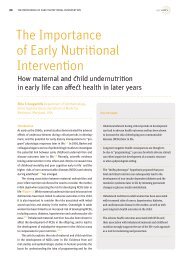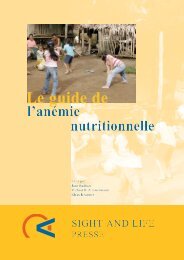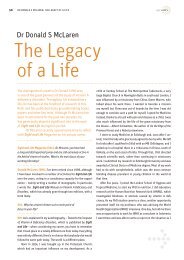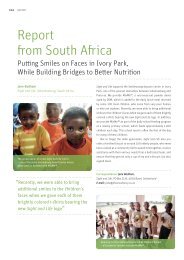Newsletter 02 2006.pdf - Sight and Life
Newsletter 02 2006.pdf - Sight and Life
Newsletter 02 2006.pdf - Sight and Life
Create successful ePaper yourself
Turn your PDF publications into a flip-book with our unique Google optimized e-Paper software.
SIGHT AND LIFE 12<br />
NEWSLETTER 2/2006<br />
Richard Kuhn<br />
George Wald<br />
ure of night blindness (pupillary<br />
response) (21), subject-friendly<br />
collection of blood specimens<br />
(dry blood spots) for subsequent<br />
quantitative analysis either in the<br />
field or at a base laboratory (22)<br />
<strong>and</strong> assessing whole body stores<br />
(isotope dilution) (23). The application<br />
of new intrinsic carotenoid<br />
labeling methods offers greater<br />
ability to trace individual carotenoids<br />
from vegetables containing<br />
them in their natural matrices to<br />
their uptake from the gut <strong>and</strong> utilization:<br />
hence, to a more accurate<br />
measure of bioavailability (24).<br />
Programs<br />
Intervention programs are moving<br />
beyond strictly distributing<br />
nutrient supplements. These<br />
programs are becoming more<br />
integrated <strong>and</strong> viewed more<br />
holistically within the context of<br />
undernutrition, underdevelopment<br />
<strong>and</strong> poverty. Micronutrient<br />
fortified foods that can address<br />
both specific deficiencies <strong>and</strong> caloric<br />
undernutrition are available<br />
in many countries. They include<br />
vitamin A fortified sugar, oils, <strong>and</strong><br />
some cereals, to name a few, but<br />
access by the poor at greatest<br />
risk still varies greatly, especially<br />
in rural areas with limited market<br />
access. And public health measures<br />
including promotion <strong>and</strong><br />
support for breastfeeding, exp<strong>and</strong>ed<br />
immunization coverage,<br />
parasite control programs, <strong>and</strong><br />
home-based control of severe diarrheal<br />
disease have contributed<br />
to decreased infectious morbidity<br />
<strong>and</strong> mortality <strong>and</strong>, hence,<br />
improved individual <strong>and</strong> national<br />
HAPC Oomen<br />
development. Although improvements<br />
are occurring in availability<br />
of potable water <strong>and</strong> environmental<br />
sanitation, the UN reports<br />
(Los Angeles Times, March 10)<br />
that over 1.1 billion living in impoverished<br />
communities remain<br />
without safe water. Yet in spite of<br />
all the progress made, including<br />
distribution of over 400 million<br />
vitamin A capsules annually (18),<br />
vitamin A deficiency remains a<br />
significant public health problem.<br />
A diet inadequate in vitamin A-<br />
containing food sources is the<br />
underlying cause of deficiency.<br />
Yet until recently food-based approaches<br />
that impact on underlying<br />
causes of underdevelopment,<br />
undernutrition <strong>and</strong> micronutrient<br />
deficiencies were the step-child<br />
intervention least attractive to<br />
international funding agencies.<br />
How did we get from<br />
there (1960) to here<br />
(2006)? Some significant<br />
decade milestones<br />
1960–1970: Progress<br />
in underst<strong>and</strong>ing basic<br />
metabolism<br />
The decade of the 1960s was the<br />
period that in my reflective view<br />
was noted mostly for advances in<br />
underst<strong>and</strong>ing the basic metabolism<br />
of vitamin A <strong>and</strong> provitamin A<br />
carotenoids. Central cleavage of<br />
beta-carotene in James Olson’s<br />
(25) <strong>and</strong> DeWitt Goodman’s (26)<br />
laboratories by enzymes isolated<br />
from the gut <strong>and</strong> liver of rats advanced<br />
knowledge of bioconversion<br />
mechanisms. In humans,<br />
efficient uptake of dietary retinol<br />
<strong>and</strong> conversion of β-carotene to<br />
retinal, esterification to retinyl<br />
esters, transport of the esterified<br />
product in lymph chylomicra <strong>and</strong><br />
hepatic uptake from chylomicra<br />
remnants were demonstrated (27).<br />
Retinol binding protein (RBP) was<br />
isolated <strong>and</strong> partially characterized<br />
in 1968, <strong>and</strong> subsequently<br />
its role in hepatic mobilization <strong>and</strong><br />
transport of retinol as holo-RBP<br />
complexed with transthyretin was<br />
defined (28). Underst<strong>and</strong>ing of<br />
the reversible formation of single,<br />
bi- <strong>and</strong> trimolecular complexing<br />
clarified how the exchange<br />
of retinol from blood to tissues<br />
occurred without loss through<br />
kidney filtration. Furthermore, the<br />
concepts revealed in defining the<br />
metabolism of RBP provided the<br />
basis in the following two decades<br />
for a new indirect assessment of<br />
depleted hepatic stores, the relative<br />
dose response (RDR) in my<br />
laboratory (29), its modification<br />
(MRDR) in James Olson’s laboratory<br />
(30) <strong>and</strong> its current broad use<br />
in assessment of vitamin A status<br />
in human <strong>and</strong> animal studies.<br />
On the public health front progress<br />
was slow. In 1964 the first ‘guestimate’<br />
of the global magnitude<br />
of deficiency was made. The approximation<br />
of 20,000 to 100,000<br />
affected children was based<br />
largely on interviews <strong>and</strong> subjective<br />
information on the prevalence<br />
of eye signs (31), which did not<br />
generate political support for<br />
large intervention programs, even<br />
though severe vitamin A deficiency<br />
in children was very evident in<br />
developing countries, often associated<br />
with PEM, <strong>and</strong> too often<br />
inappropriately managed leading<br />
to irreversible blindness, if the patient<br />
survived. Many of us involved<br />
in international child health issues<br />
during the 1960s were appalled<br />
by the lack of attention to this<br />
preventable public health scourge,<br />
but there was no organized group<br />
to champion the cause at a political<br />
level <strong>and</strong> attract substantial<br />
funds for prevention.


